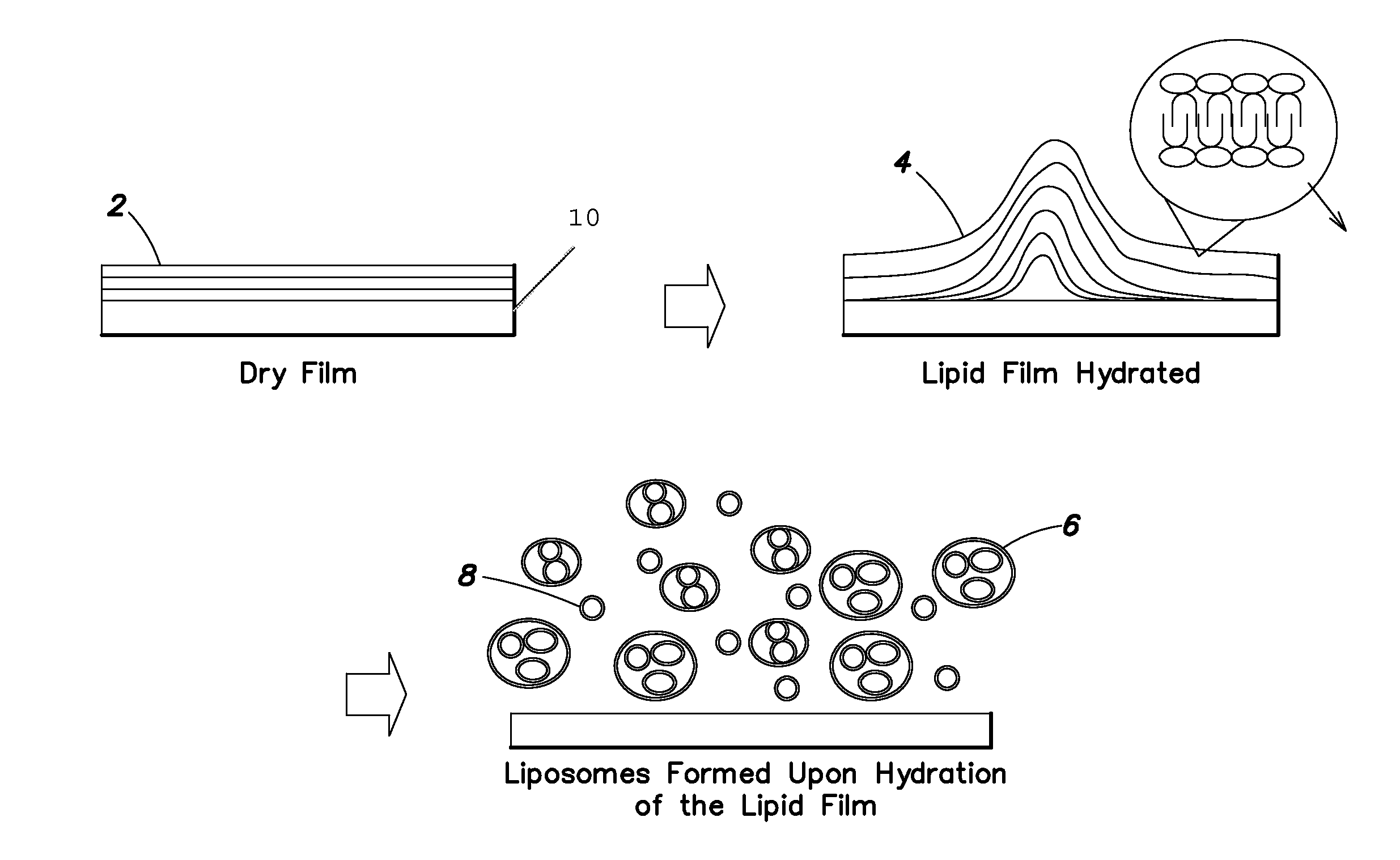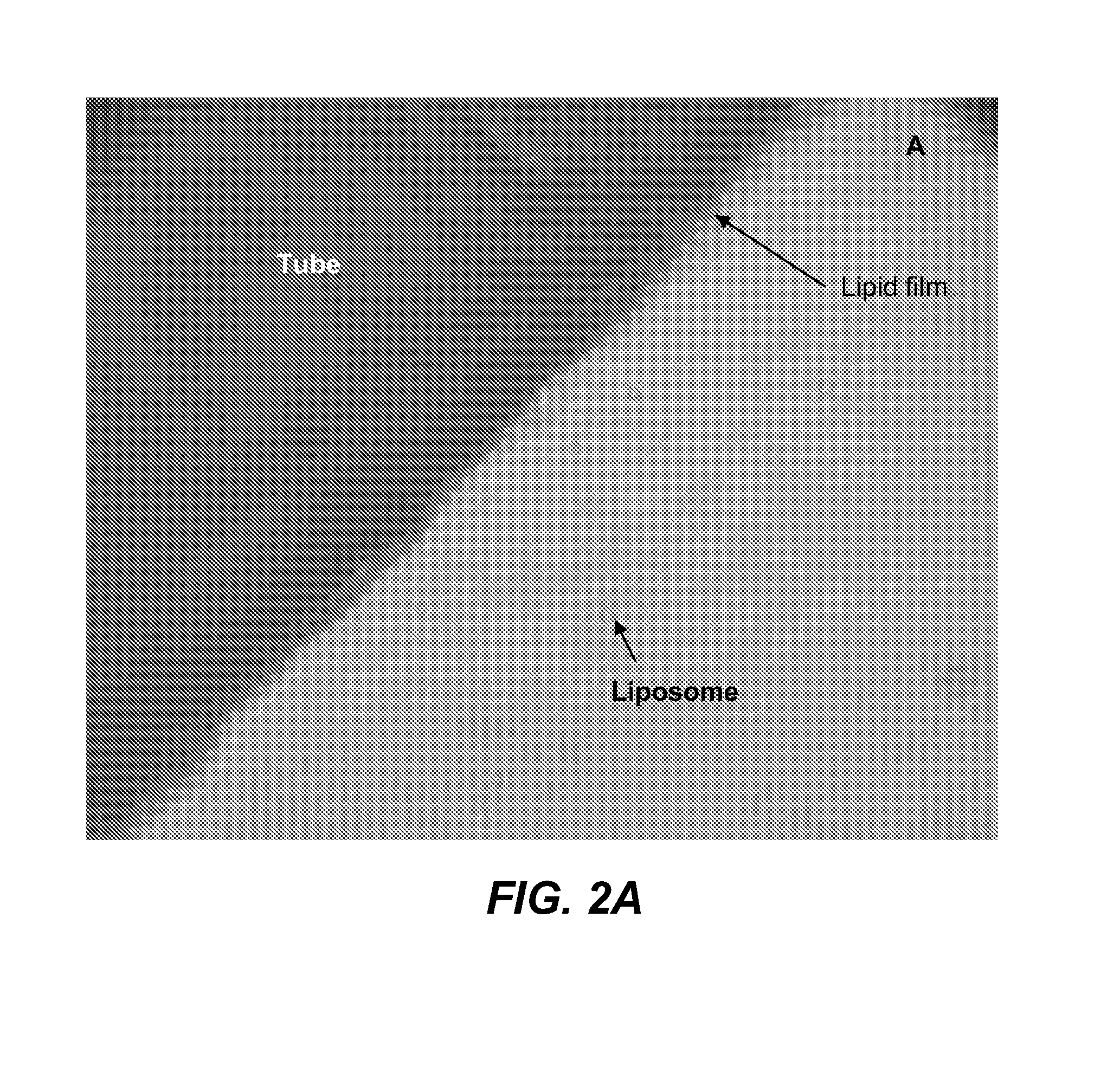Coatings for implantable medical devices for liposome delivery
- Summary
- Abstract
- Description
- Claims
- Application Information
AI Technical Summary
Benefits of technology
Problems solved by technology
Method used
Image
Examples
example 1
[0177]This Example describes a method for producing a dry phospholipid film. Liposome formation from the film in aqueous solution is observed optically. L-α-Phosphatidylcholine (PC, from soybean) and cholesterol were dissolved in dichloromethane. Paclitaxel (PTX), as a model hydrophobic drug, was added to this solution to produce Formulation B. The weight percent of cholesterol in Formulation B is 10% of the total lipid. The precise amounts of various components are listed in Table 1.
TABLE 1Composition of Formulation BIngredientsFormulation BPC (g)0.18Cholesterol (g)0.02Paclitaxel (g)0.07DCM (mL)10Total of solid0.27phase (g)
[0178]Formulation B was sprayed on a stainless tube and the tube was placed in a vacuum oven (Napco model 5831, Thermo Electron Corporation) for 12 hours at 30 in. Hg to remove solvent at room temperature. The tube was placed in 1 ml of phosphate buffer solution (PBS). Optical micrographs were obtained from the coating at different time intervals using an inverte...
example 2
[0179]This Example describes the preparation of a lipid film comprising a hydrophobic drug and the ability to tailor the amount of liposome formation by changing the amounts of lipid in the dry film. Two different formulations (Formulations A and B) were prepared comprising a mixture of lipids L-α-phosphatidylcholine (PC, from soybean) and cholesterol dissolved in dichloromethane. The weight percent of cholesterol in Formulation A was 30% of the total lipid and in Formulation B is 10%, and the precise amounts are listed in Table 2. Paclitaxel (PTX), as a model hydrophobic drug, was added to this solution. One hundred μL of the above solution added to a round bottom tube and was dried under vacuum (30 inches Hg) for 12 hours in order to remove solvents, simulating the formation of a lipid film on the surface of a substrate.
TABLE 2Composition of Formulations A and BIngredientsFormulation AFormulation BPC (g)0.140.18Cholesterol (g)0.060.02Paclitaxel (g)0.070.07DCM (mL)55Total of solid0...
example 3
[0186]This Example demonstrates the formation of a lipid film comprising a hydrophilic drug via an emulsion method.
[0187]Lecithin (0.14 g) and cholesterol (0.06 g) are dissolved in 9 mL of dichloromethane (solution 1). Imatinib mesylate (0.0641 g) is dissolved in 200 μL of distilled water (solution 2). Solution 2 is added drop-wise into solution 1 to form an (emulsion 1). Ethanol (2 mL) is added to emulsion 1 to obtain a clear emulsion. The emulsion is then applied on the surface of the medical device.
PUM
| Property | Measurement | Unit |
|---|---|---|
| Fraction | aaaaa | aaaaa |
| Thickness | aaaaa | aaaaa |
| Thickness | aaaaa | aaaaa |
Abstract
Description
Claims
Application Information
 Login to View More
Login to View More - R&D
- Intellectual Property
- Life Sciences
- Materials
- Tech Scout
- Unparalleled Data Quality
- Higher Quality Content
- 60% Fewer Hallucinations
Browse by: Latest US Patents, China's latest patents, Technical Efficacy Thesaurus, Application Domain, Technology Topic, Popular Technical Reports.
© 2025 PatSnap. All rights reserved.Legal|Privacy policy|Modern Slavery Act Transparency Statement|Sitemap|About US| Contact US: help@patsnap.com



